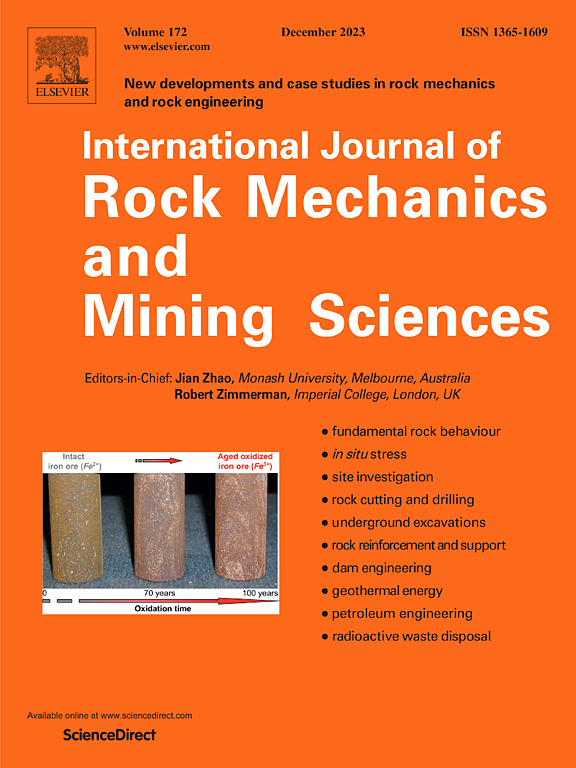微波诱导基性岩石强度降低及弱化机制
IF 7
1区 工程技术
Q1 ENGINEERING, GEOLOGICAL
International Journal of Rock Mechanics and Mining Sciences
Pub Date : 2025-04-21
DOI:10.1016/j.ijrmms.2025.106115
引用次数: 0
摘要
基性岩石因其高强度和高微波灵敏度而被认为是微波破碎的理想材料。然而,目前对微波辐照下基性岩石的加热特性和软化机理还没有系统的研究。本研究通过对2种不同孔隙度的辉绿岩和3种不同孔隙度的玄武岩进行多模微波辐照实验,分别研究了微波条件和岩石性质对基性岩加热特性和弱化效应的影响。结果表明,5种基性岩石在微波辐照下的升温速率基本一致,孔隙度对基性岩石的升温特性影响较小。微波辐射作用下基性岩石既有开裂破坏模式,也有剥落破坏模式。其中辉绿岩1号、玄武岩1号、玄武岩2号和玄武岩3号表现为开裂破坏。随着辐照时间的增加,岩石的最高表面温度、微波诱导裂纹的数量和宽度、体积膨胀量、纵波速度降低量和强度降低量均逐渐增加。在相同的微波辐照条件下,辉绿岩的破坏一般比玄武岩的破坏更为突出。随着孔隙度的增加,玄武岩1号、2号和3号的弱化作用逐渐减弱。在较低的微波功率和较短的照射时间下,辉绿岩#2出现了剥落破坏,这与微波照射下辉绿岩内部的氧化铁和碳酸盐杏仁核快速加热和化学分解有关。本文章由计算机程序翻译,如有差异,请以英文原文为准。
Microwave-induced strength reduction and weakening mechanisms of basic rocks
Basic rocks are considered ideal materials for microwave breaking due to their high strength and high microwave sensitivity. However, the heating characteristics and weakening mechanisms of basic rocks under microwave irradiation have not been systematically investigated. In this study, the multimode microwave irradiation experiments were conducted on two types of diabase and three types of basalt with varying porosities to investigate the effects of microwave conditions and rock properties on the heating characteristics and weakening effects of basic rocks, respectively. The results indicate that all five basic rocks exhibited similar heating rates under microwave irradiation, and the porosity had a minor impact on the heating characteristics of basic rocks. Both cracking and spalling failure modes occurred in basic rocks under microwave irradiation. Specifically, diabase #1, basalt #1, basalt #2 and basalt #3 exhibited cracking failure. As the irradiation time increased, the highest surface temperature of the rocks, the number and width of microwave-induced cracks, the amounts of volume expansion, P-wave velocity reduction and strength reduction of microwave-treated rocks all progressively increased. Under the same microwave irradiation conditions, the failure of diabase was generally more prominent than that of basalt. Additionally, the weakening effects on basalt #1, basalt #2, and basalt #3 gradually diminish with increasing porosity. Diabase #2 exhibited spalling failure under a low microwave power and a short irradiation time, which is related to the rapid heating and chemical decomposition of iron oxides and carbonate amygdales filling the pores within diabase under microwave irradiation.
求助全文
通过发布文献求助,成功后即可免费获取论文全文。
去求助
来源期刊
CiteScore
14.00
自引率
5.60%
发文量
196
审稿时长
18 weeks
期刊介绍:
The International Journal of Rock Mechanics and Mining Sciences focuses on original research, new developments, site measurements, and case studies within the fields of rock mechanics and rock engineering. Serving as an international platform, it showcases high-quality papers addressing rock mechanics and the application of its principles and techniques in mining and civil engineering projects situated on or within rock masses. These projects encompass a wide range, including slopes, open-pit mines, quarries, shafts, tunnels, caverns, underground mines, metro systems, dams, hydro-electric stations, geothermal energy, petroleum engineering, and radioactive waste disposal. The journal welcomes submissions on various topics, with particular interest in theoretical advancements, analytical and numerical methods, rock testing, site investigation, and case studies.

 求助内容:
求助内容: 应助结果提醒方式:
应助结果提醒方式:


